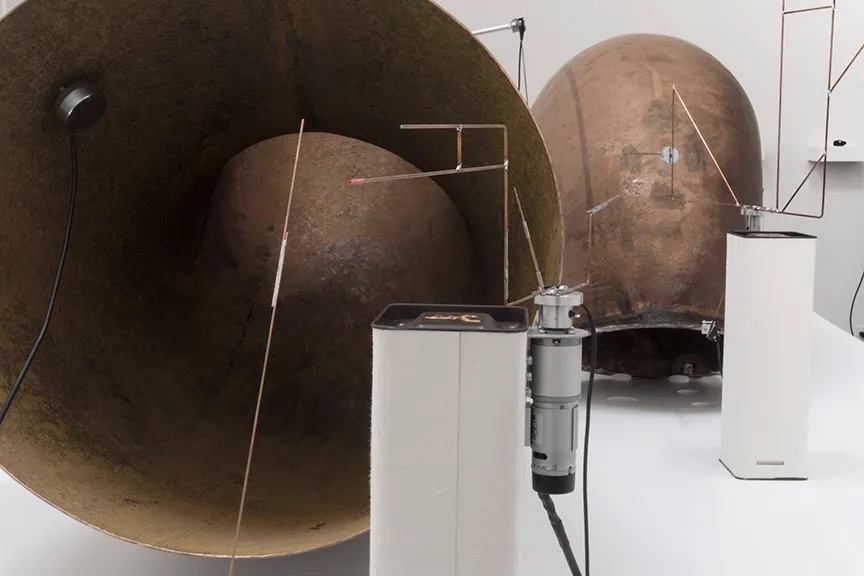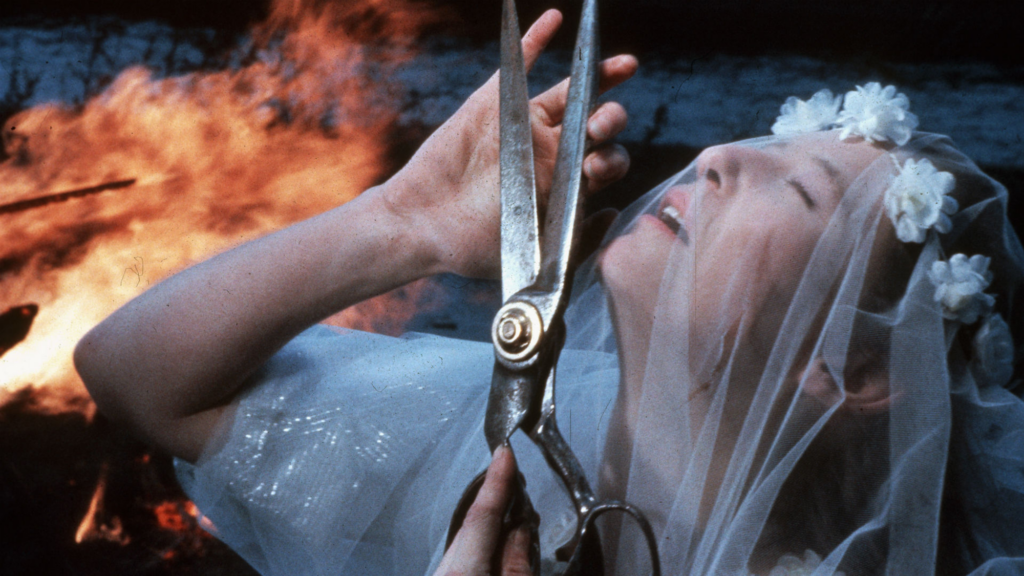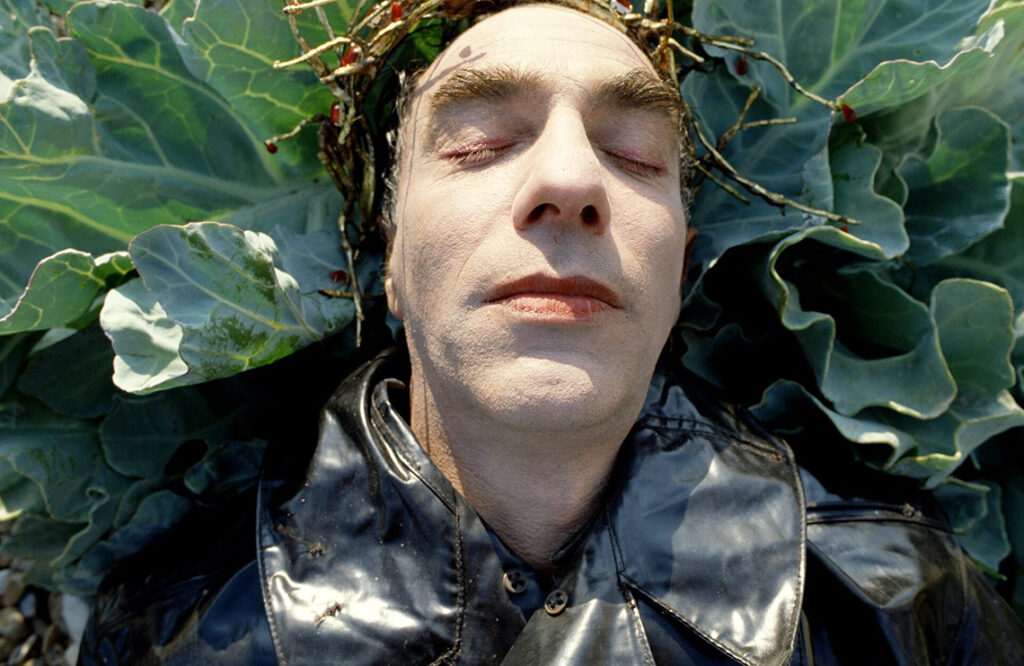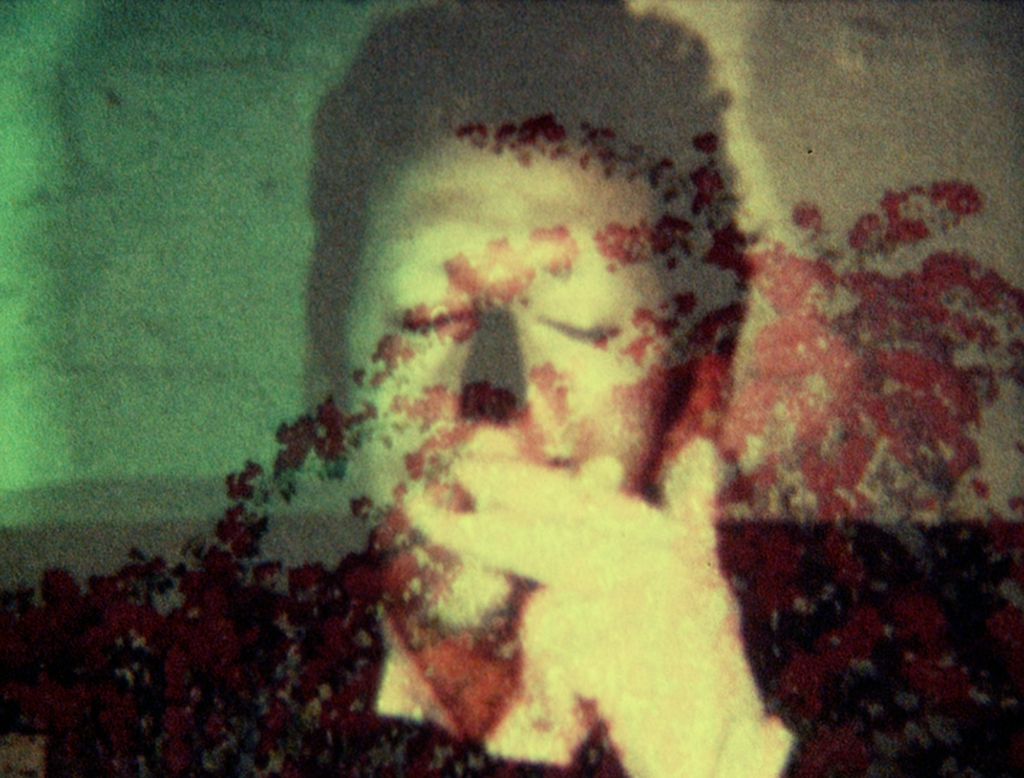
In the context of Courtisane Festival 2025 (Gent, 2 – 6 April 2025).
I was describing the garden to Maggi Hambling at a gallery opening. And said I intended to write a book about it.
She said: “Oh, you’ve finally discovered nature, Derek.”
“I don’t think it’s really quite like that,” I said, thinking of Constable and Samuel Palmer’s Kent.
“Ah, I understand completely. You’ve discovered modern nature.”
Derek Jarman, 3 February 1989
In Modern Nature, a volume of his journals written between 1989 and 1990, Derek Jarman’s narrativisation of the process of tending his garden eschews the romantic predilection for nature’s pristineness and focuses instead on the survival of herbs and flowers in a place where they should not thrive. The allegory is palpable here, for just as violets and daffodils and poppies bloom among the stones in the shadow of the nuclear plant which overlooks his cottage, Jarman and the marginalised communities he invokes in his work also demonstrate their struggle and their resilience in the face of the personal, cultural, and social crisis of Thatcherite Britain. In light of Jarman’s work, tending nature can be seen as an emergency praxis whose imperative opens onto a consideration of the relationships between time and community, human and other-than human life, inviting us to rethink the possibilities for worldmaking in times of crisis.
The legacy of Derek Jarman, especially his garden at Prospect Cottage, provides us with a variety of entry points through which we can think through questions of interspecies relationality and affective ecology. This programme brings together a wide variety of cinematic approaches that seek to understand and respond to these questions and inspire an ecopolitics accentuating pleasure, play or improvisation within and among species. A series of films that engage in and with practices of gardening, seeding, re/wilding or foraging, while challenging the dominant politics of extraction and extinction associated with the imperatives of perpetual growth and expansion. Film works that evoke the tangled and venturesome histories that we need to imagine in order to become again of and from the world — to sow worlds beyond oppressive boundaries and binarities. As Jarman noted in his diary: “There are no walls or fences. My garden’s boundaries are the horizon.”
to whom it may concern
in the dead stones of a planet
no longer remembered as earth
may he decipher this opaque hieroglyph
perform an archaeology of soul
on these precious fragments
all that remains of our vanished days
here — at the sea’s edge
I have planted a stony garden
dragon tooth dolmen spring up
to defend the porch
steadfast warriors
Derek Jarman, 13 February 1989
With the support of the French Embassy in Belgium and the Institut français. As part of EXTRA, a program that supports French contemporary creation in Belgium.
Thanks to all the filmmakers and distributors, Teresa Castro, Ricardo Matos Cabo, Nicolas Feodoroff, Kristofer Woods
——————–
SCREENING 1
4 April, 2025 – 19:30
Sphinx Cinema – zaal 3

Sept promenades avec Mark Brown
Pierre Creton, Vincent Barré, FR, 2024, 16mm to digital, 104′
Nearly twenty years ago, Pierre Creton and Vincent Barré searched for wild flowers in their natural environment in Northern India in L’Arc d’iris, souvenir d’un jardin (2006). After seeing the film, British botanist Mark Brown, who has devoted his life to recreating a primeval forest in his own garden in Normandy, expressed the wish to collaborate with the filmmakers on a similar project. Sept promenades avec Mark Brown makes this idea a reality a year after Creton’s Un Prince (2023), in which Brown appeared speaking to students (including Antoine Pirotte, the young cinematographer of both films). Divided in two parts, this “phytocentric road movie” first includes seven sequences where Brown casually leads a small group who are scouting for Indigenous plants in places abandoned by human activity while sharing his ecological knowledge and convictions with them. Shot digitally, it naturally transitions into a second part shot on 16mm entitled “Herbarium”, which showcases the previously collected plants and flowers. It is strangely moving to see Creton, whose body of work is associated with digital images, tap into celluloid and thus the origins of cinema, like plants turning toward the light and blooming in pure photochemical delight. (Antoine Thirion — Viennale)
In the presence of Pierre Creton & Vincent Barré
——————–
SCREENING 2
6 April, 2025 – 17:30
ARCA

Black Pond
Jessica Sarah Rinland, UK, AR, 2018, 16mm to digital, 42′
Black Pond explores the activity within a common land in the south of England. Previously occupied by the 17th century agrarian socialists, the Diggers, the land is currently inhabited by a Natural History Society whose occupations include bat and moth trapping, mycology, tree measuring, and botanical walks. After two years of filming on the land, the footage was shown to the members of the Society. Their memories and responses were recorded and subsequently used as part of the film’s narration. The film does not offer a comprehensive record of the history of humans within the area. Instead, it explores more intimately human’s relationship with and within land and nature. “Humanity is in symbiosis with its surroundings, and the open wings of a moth rest in the open hand of its researcher, as if his body was an extension of the landscape; another cut down tree, or another boulder, maybe. This common effort is a testimony in itself, but combined with the oral narration of the film, it becomes a double strategy where language is also the protagonist of the movie itself, rendering its condition of documentary in 16mm to a different piece of moving image akin to a pulsing metaphor, a manifestation in the materic support of celluloid, a call to arms of sorts, the necessity of listening with our own eyes to achieve a further understanding.” (José Sarmiento Hinojosa)
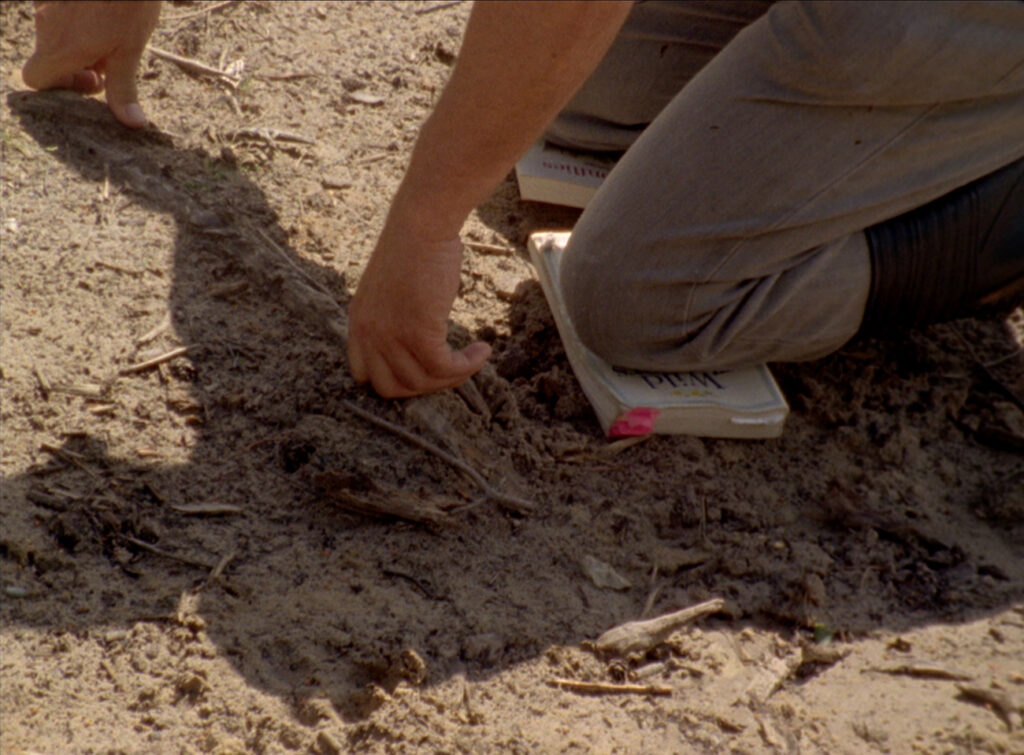
Black Pond: The Society
Jessica Sarah Rinland, performance
A performance which further explores the process of research undertaken for Black Pond, an odyssey across a common land in the south of England told through the hands of the members of the local Natural History Society. The performance uses yearly town hall meetings, historical maps and laws, letters of complaint, e-mails, and footage shot in the same location years before, to paint a wider picture of the social history of the area and the relationship between the artist and the Natural History Society.
In the presence of Jessica Sarah Rinland
——————–
SCREENING 3
5 April, 2025 – 22:30
Sphinx Cinema – zaal 3

The Secret Garden
Nour Ouayda, LB, 2023, 16mm to digital, 27′
The inhabitants of a city awake one morning to find that never-before-seen trees, plants, and flowers suddenly erupted throughout the streets and in the squares. Strange and mysterious events start taking place as Camelia and Nahla investigate the origins of these new and peculiar creatures. “The image that inspired the film was that of a plant in the dark illuminated by a flashlight. I think there was something about the appearance and disappearance of the plant under the movement of the flashlight that captivated me. It was also an image that made me feel that something mysterious was about to happen. So I started making images of plants at night, plants that I found in the streets of Beirut. I took these images with my mobile phone. Little by little, I found myself collecting images of plants that I came across here and elsewhere, night and day. It became an obsession. I noticed the way they occupied the space. I had the impression that they were coming from somewhere else, that they weren’t part of the urban fabric of the city but were intruding on it. I grew up with the image of Beirut as a concrete city with no trees or plants. This is true, in the sense that there are no green spaces such as parks, gardens and woods. It’s true that concrete takes up a lot of space, but the flora exists, it’s just that it’s wild and not really organised. That’s all I could see in the city: trees, plants and flowers. This stubbornness created in my imagination the story of a hidden garden that would be the origin of the presence of plants in this concrete city.” (Nour Ouayda)

Foragers
Jumana Manna, 2022, digital, 64′
Moving between scripted scenes, documentary and archival footage, Foragers explores how the traditional Palestinian practice of foraging wild edible plants — namely ’akkoub and za’atar — is criminalised by the Israeli government. For Palestinians, these laws constitute an ecological veil for legislation that further alienates them from their land while Israeli state representatives insist on their scientific expertise and duty to protect. Following the plants from the wild to the kitchen, from the chases between the foragers and the nature patrol, to courtroom defenses, Foragers captures the inherited love, joy and knowledge in these traditions alongside their resilience to the prohibitive law. By reframing the terms and constraints of preservation, the film raises questions around the politics of extinction, namely who determines what is made extinct and what gets to live on. “As much as the film is about all of the legal battles that Rabea has worked on, the starting point was a place of joy, from really loving to be out in nature finding, picking, and learning about all of these different plants. I mean, it’s quite an incredible feeling in the springtime in Palestine. You don’t really need to go to the supermarket. There are so many wild-growing edibles, it is magical. That was very central when I started working on the film, and I wanted it to remain central. I wanted joy to be felt as much if not stronger than the anger towards the criminalization of the practice.” (Jumana Manna)
In the presence of Nour Ouayda, Jumana Manna
——————–
SCREENING 4
3 April, 2025 – 17:00
KASKcinema

Les Jardiniers du Petit Paris
Sophie Roger, FR, 2009, digital, 34′
Through her window, Sophie Roger films her neighbours tending a community vegetable garden as seasons pass by. At the same time, she reads passages from Tristes tropiques and regularly abandons her observation post to enter the frame, meet her neighbours, ask them to pose for filmed portraits. “I hate voyages and explorers”, as Claude Lévi-Strauss warns the readers of his Tristes tropiques. A warning that caused quite a stir given that his book looked back on his stay in Brazil and developed a reflection on his first anthropological experience among the Bororos, Nambikwaras and Tupi-Kawahibs. And, importantly, it was written in 1954–1955, fifteen years after his return. A matter of distance. How can we read this text today? What does it mean to read in the present? Thanks to Sophie Roger, we are safe and sound. For her first film, no distant expedition. Her anthropological gesture combines the inside and outside, what is said and what is seen. Where? In France, in a place known as “Little Paris”, a community garden is observed from a window. Outside: as seasons change, gardeners of all ages come and go, wait, pace up and down their furrows, bustle about and also have fun. Inside: a whispering voice reveals the book, chapter by chapter, in the confines of the invisible house, where we hear only discreet noises, the creak of footsteps in a stairway, the rustle of pages being turned, muffled snippets of music. The words from far away and yesterday resonate with the images of here and now. Far from the tropics, a gaze filled with wonder is being constructed. One that involves each of us cultivating our attention like a fragile plant, far from the monoculture foretold by the worried anthropologist. (Nicolas Feodoroff — FID)

Hic Rosa, partition botanique
Anne-Marie Faux, FR, 2006, 35mm, 57′
Hidden behind the name of the most famous of flowers there lies a homage. To what? To the colour red, to flushing women. To women enraged by justice like Rosa Luxembourg; to women engaged in the austere precision of an art of truth like Danièle Huillet. Because — it is quite clear and the dates in the subtitles in the credits confirm it (1916/1936/2006) — the voices of one or the other cross the “botanical symphony” that reveals the images in sequence. It is the latter’s concern for precision that is heard in the diction of the letters written in 1916 by the former. While Rosa Luxembourg is known for having been the heroic organiser Spartacist, who was assassinated by the police in 1919, it is another timbre than that of combative militant that resonates here. “Do you remember what we were planning to do when the war is over?” she writes to one of her correspondents. Such is the subject matter of these letters: the certain memory of the future. The hauntingly insistent reminder of the causes for which the struggle must be led. If a revolution is to be undertaken, and with all the necessary devotion, it is, to exclude oneself from a project bound to the rational. To what end then? To rediscover the gracious and inconsequential innocence of the original garden. To become animal or plant again, nature without fatality. Return, all in all and according to a familiar messianism, to Master Eckhart’s famous mystical programme “the rose does not have a why”. In this first long film, Anne-Marie Faux celebrates the passion of unhindered floral existence without yielding anything to the demands that such an ambition requires. (Jean-Pierre Rehm — FID)
In the presence of Sophie Roger
——————–
SCREENING 5
5 April, 2025 – 16:00
Sphinx Cinema – zaal 3
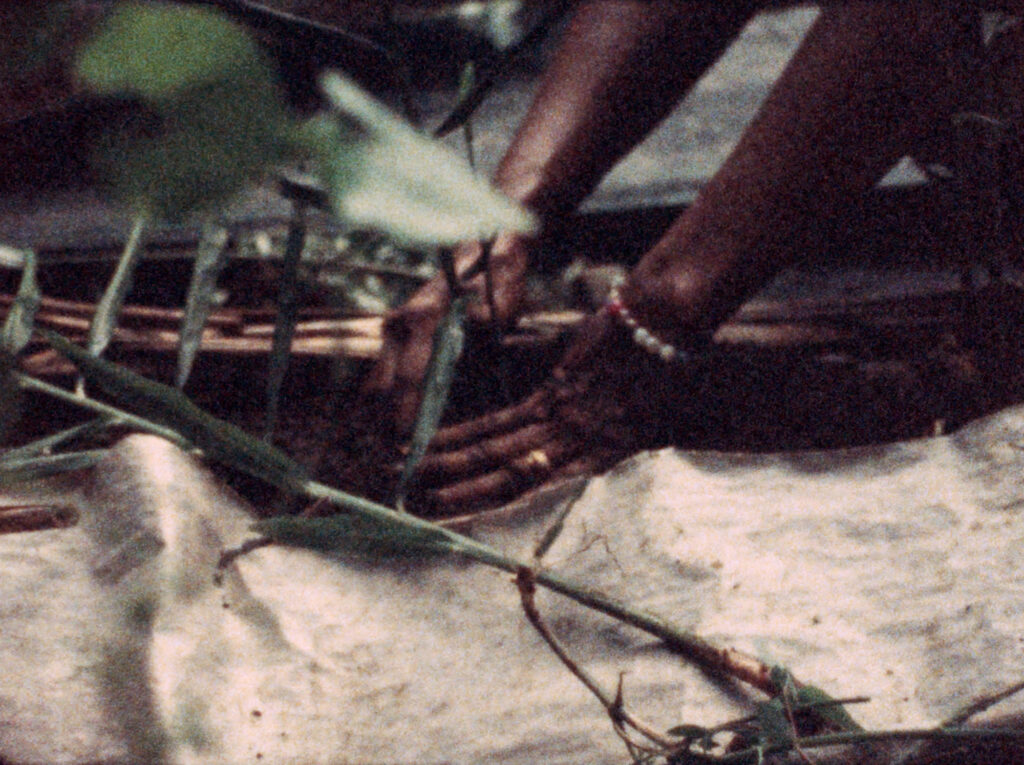
Le Jardin
Frédérique Menant, FR, 2019, 16mm to digital, 16′
Thérèse cultivates a Creole garden in Guadeloupe. She resists invisible poisons. Her hands merge with the earth. Her face with the light. “The garden was part of a decolonial activism for Thérèse, as it was a means of cultivating the land by her own means and cleaning it up in the face of widespread pollution. Historically, chlordecone is an insecticide used on a massive scale in the French West Indies and placed on the market in an abusive manner at the beginning of the 1970s, by dispensation of the Minister of Agriculture at the time, Jacques Chirac. Intended to combat banana parasitism, its industrial and colonial use led to pollution of natural environments and poisoning of plant, animal and human life. Frédérique Menant’s film places eco- logical awareness at the heart of the ecofeminist and post-colonial question: the garden becomes a utopian land of rewilding, of regaining power, of regeneration. By placing the relationship between the cultivated and the wild within the same filmic and agrarian perimeter, the filmmaker leaves behind Western dualism to reclaim the idea of continuity: ‘Recognise the culture that has been denied in the sphere conceived as pure nature, and recognise the nature that has been denied in the sphere conceived as pure culture.’” (Elio Della Noce)

Shape Shifting
Elke Marhöfer, Mikhail Lylov, DE, JP, 2015, 16mm to digital, 18′
In order to challenge the understanding of nature situated apart from human, Shape Shifting suggest another arrangement where human and nonhuman join relations and productively interact. It outlines an affective cartogra- phy of a specific landscape, which exhibits a high natural diversity and is called “satoyama” in Japanese.“Mapping onscreen the enmeshments and intimacies that bind together humans and other-than-humans such as weeds — what Shape Shifting does by delving into the Japanese satoyama (the border zone or area between mountain foothills, yama, and the arable flat land next to the villages, sato) — Lylov and Marhöfer show us that exploring the other-than-human by means of film is already a means of shaping affective relationships encompassing human and machinic fellows. The joyful myriad of other-than-human agents potentially implicated are far from being limited to organic actants… Shape Shifting reminds us that other-than human subjects hint at specific modes of sensing, feeling, affecting, and being affected. Filming here means attuning human makers and human spectators to the sensibilities of the soil, weeds, and wind. In this sense, the film is an experiment in becoming with, a matter of alliances and counter-encounters.” (Teresa Castro)

Accession
Tamer Hassan, Armand Yervant Tufenkian, US, 2018, 16mm to digital, 49′
Shot over a period of five years in 13 locations around the U.S, Accession traces an intimate collection of letters, originally written to accompany seed packets sent between friends and family across the United States, which date as far back as 1806, and are poetically narrated as reflections of life in rural America. “Heirloom seeds and 16mm film embody memory in a becalmed epistolary tour of American experience. Read aloud in mellifluous regional accents, letters between ‘seed-savers’ suspend us in a fading vision of an agrarian nation, where generation after generation has handed down and cultivated the same peas, gourds, marigolds, and hyacinths. The places across the United States where Hassan and Tufenkian shot their film over several years—the same origins and destinations for the letters we hear — contain not just timeless farmlands but also cars and railroads of contemporary vintage (as well as, oddly enough, a couple of performers in a historical reenactment). The effect is a kind of secular prayer and a paean to decency and communal duty, as the diversity of the seeds and weathered film stocks feed a soulful sense of continuity that stretches from the 1800s up to now. “It doesn’t seem right to throw away [experience],” one correspondent writes, and in the silences between the letters (passing through states such as Oklahoma, Mississippi, and Louisiana), the filmmakers create a space for unhurried contemplation of what lies before us.” (Nicolas Rapold—Viennale)
In the presence of Frédérique Menant, Elke Marhöfer, Tamer Hassan & Armand Yervant Tufenkian
This screening is followed by a conversation between Teresa Castro and Frédérique Menant, Elke Marhöfer, Tamer Hassan & Armand Yervant Tufenkian.
Teresa Castro is Associate Professor in Film Studies at the Université Sorbonne Nouvelle — Paris 3. A significant part of her recent research has focused on the links between cinema and animism, on forms of plant life in visual culture and on the environmental histories of film and photography.
——————–
SCREENING 6
5 April, 2025 – 11:00
Sphinx Cinema – zaal 3

Glimpse of the Garden
Marie Menken, US, 1957, 16mm, 5′
In this brief film, Marie Menken carefully probes the layers of a lush garden, shifting from the macro to the micro and then back again. “Marie’s films were her flower garden. Whenever she was in her garden, she opened her soul, with all her secret wishes and dreams.” (Jonas Mekas)

Garden Pieces
Margaret Tait, UK, 1998, 16mm, 12′
A set of three ‘film poems’ composed around the theme of the garden — the central one featuring hand scratched animated drawings. Margaret Tait described them as follows: ‘Round the Garden’ — right round and round again, ‘Garden Fliers’ — flighty cartoon and a stunner of a piano piece and ‘Grove’ — grave and sonorous.

True to Life
Gunvor Nelson, SE, 2006, digital, 38′
True to Life was shot in my garden in Kristinehamn in Sweden. I had bought a few closeup lenses for my camera, and when I put them together I discovered another world and started filming it. Then I amplified the sound of the camera brushing against the vegetation. (Gunvor Nelson)

Gesamthof / A lesbian garden
Anne Reijniers & Eline De Clercq, BE, 2022, digital, 15′
Gesamthof / A lesbian garden is an art — nature project that lives between the walls of an old Antwerp monastery. We follow gardener and artist Eline De Clercq as she relates the garden to topics such as botanical colonialism, the ambiguity of naming, the social expectations of women and the search for a lesbian identity.

Wenn du eine Rose siehst
Renate Sami, DE, 1995, 16mm, 4′
Under the spell of Cathy Berberian’s voice, scraps of melodies and poems in my head. In love with spring and summer’s flowers I walked through streets and gardens, pastures, fields and forests and by the end of that summer 1995 I had a little film which ends somewhat melancholically with some chords of Gustav Mahler’s Traveling Journeyman‘s Songs. (Renate Sami)
In the presence of Anne Reijniers & Eline De Clercq
——————–
SCREENING 7
3 April, 2025 – 14:00
KASKcinema

The Magino Village Story — Raising Silkworms
Ogawa Productions, JP, 1977, 16mm, 112′
Raising Silkworms, shot in 8mm, was made when the Ogawa Productions group (whose work was presented at Courtisane festival 2017 and at Cinematek in 2019) was invited to settle in Magino, a village in the mountainous region of Yamagata in northern Japan. They moved into a barn lent by a farmer-poet which they converted into a home and film studio. Their first film there was made under the direction of Shiraishi Yoko, Ogawa Shinsuke’s wife, and draws us into the world of raising silkworms under guidance of Sato Kimura, a woman who has spent half her life with the silkworms.
“The film was originally meant to be a loose collection of visual notes on 8mm, a moving image supplement to their elaborate scrapbooks. Along the way, they could train members to operate the camera and learn other aspects of film production. However, Ogawa thought the footage was good enough to convert into a documentary. They edited the footage together, blew it up to 16mm, and it eventually became what they refer to as the Magino Village Story’s Silkworm Chapter, or Yosan-hen. Silkworms entered the village economy in Magino as late as the 1950s; however, the filmmakers mostly ignore the economic materiality of silkworm farming for process. Silkworm farming was primarily women’s work. The men would only occasionally lend a hand, which is why their film prominently features Ogawa’s wife, Shiraishi Yoko, as she learns the ins and outs of silkworms from neighbor Hatsu Kimura. The film describes every step of the process.” (Markus Nornes)
——————–

WORKSHOP: On grafting and pruning
Laura Palau Barreda
4 April, 2025 – 10:00
KASKcafe – Terrace
It is often said that those in glass houses should refrain from throwing stones. A reminder that spaces of privilege, frequently quick to critique, must instead cultivate self-awareness and transform wounds into moments of reflection and change. As Donna Haraway wisely notes, “It matters what ideas we use to think other ideas (with).” My ongoing research, Glass-House & Soft Stones at KASK, proposes not merely to think about nature but to think with it. In this context, I propose a series of experiential learning activities focused on apple tree care at the Bijloke site. Here, participants, whom I intentionally refer to as scholars in the broad sense of anyone engaged in the process of learning, will be invited to practice grafting and pruning.
For the Courtisane festival, our collective practice draw from the traditional Catalan practice of parany, where trees were pruned into conic shapes to trap birds. In this reinterpretation, we will become ensnared, forced to slow down and attune with the tree’s listening presence asits sap flows. An invitation to reflect on our intentions as practitioners and deepen our connection with Bijloke’s living archive with an essence of its fruit lingering on our tongues. (Laura Palau Barreda)
For this walk / workshop reservation is required.
